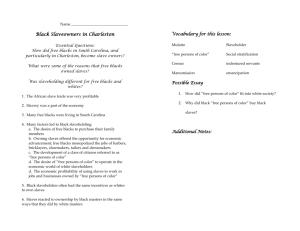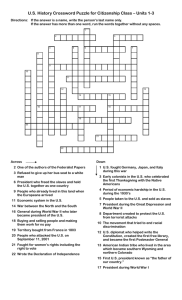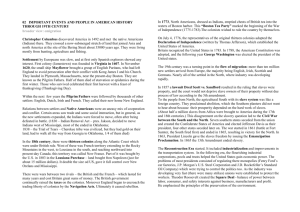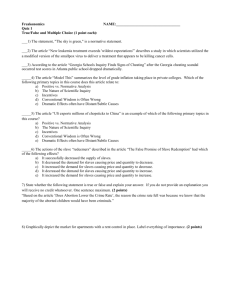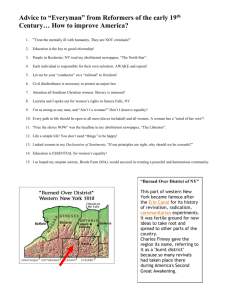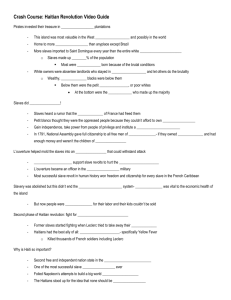Takaki PowerPoint Presentation - March 10, 2005 - Can-Do
advertisement
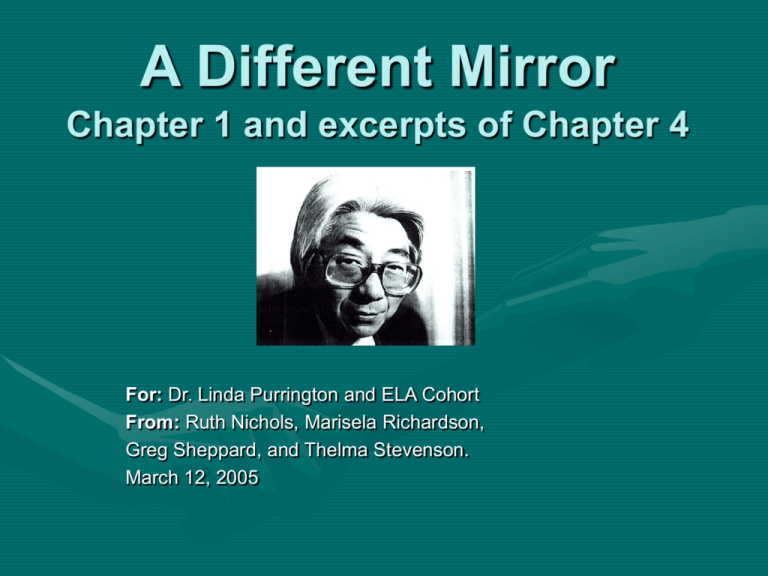
A Different Mirror Chapter 1 and excerpts of Chapter 4 For: Dr. Linda Purrington and ELA Cohort From: Ruth Nichols, Marisela Richardson, Greg Sheppard, and Thelma Stevenson. March 12, 2005 What is an American? Ronald Takaki on his way to Norfolk, Virginia to attend a conference on multiculturalism. In the cab, he had a brief conversation with the driver. Norfolk Convention Center in Virginia The cab driver asks Ronald Takaki: “How long have you been is this country?” • Ronald Takaki responds, “All my life. I was born in the United States, my family came from Japan in the 1880s.” • In a strong southern drawl, the cab driver remarks, “I was wondering because your English is excellent!” • At this point, Ronald Takaki was reminded of how important it was to be attending the conference on multiculturalism. • Somehow Ronald Takaki did not look “American” to the cab driver. Suddenly, they both became uncomfortably conscience of the racial divide that separated them. Race in America Toni Morrison – • Race has functioned as a metaphor necessary for the construction of “Americanness”. • In the creation of our national identify, American has been defined as white, with based on a Eurocentric culture. • Currently, one-third of Americans do not trace their origins to Europe. Racism and Fear • Collective fear stimulates herd instinct, and tends to produce ferocity toward those who are not regarded as members of the herd. Bertrand Russell • Fact During World II, Japanese Americans were interned. German and Italian Americans were not. Why? • In Hawaii, 1,444 Japanese were interned. Japanese Americans were a large part of the population of Hawaii. Large scale internment would disrupt the economy. p. 379 A Brief History of the United States of America • An excerpt from Michael Moore’s “Bowling for Columbine” • The clip emphasizes that fear often motivates racism, injustice, and hatred • The clips you will see are intended to challenge your preconceptions and beliefs – Just as books such as The Culturally Proficient School by Randall Lindsey and A Different Mirror by Ronald Takaki inform and challenge us • The next slide has a review from praize.com, a Christian website A Review “Bowling for Columbine” • From praize.com, a Christian Website. • Michael Moore holds up a mirror to American culture. The mirror shows us a lot about ourselves that we may be surprised to see, even though we know it's there. • Moore has masterfully blended various elements of our culture into this picture. It is enough wild ride to qualify as entertainment. But it is important because it forces us to look at our culture and see some of the serious flaws that lead to tragedies. A Brief History of the United States of America On line version of video clip http://www.bowlingforcolumbine.com/media/clips/windowsmedia.php?Clip=cartoon1021LG Racialization of Savagery - Marisela Before Columbus: Vineland Thorvald Ericksson son of Erik the Red, Vikings sail from Greenland to the New World. 1000 A.D. First Europeans settled in the New World Norwegian missionaries arrived in 1721 to find ruins of farms and churches Vikings were unacknowledged until the 1960s The Racialization of Savagery The Indians of Massachusetts Bay Native perception of the strangers (p. 24) Manitto - “God” Mannittowock - “They are Gods” The Racialization of Savagery Crucial timing for the performance of The Tempest (p. 26) “Savage Irish, our enemies” Atrocities against families (p. 27) God-given responsibilities English Expansionism Irish and Americans had parallels (p, 28) Savagery Irish/Indian Kidnappings of natives (p. 30) Aristotle’s Doctrine – Natural slaves (p. 32) English Settlement Possibility for Friendship and interdependence (p. 33) Governor Thomas Gates - Forced labor of natives to serve the colonists (p. 34) Invasion and possession of lands - Chief Powhatan Great Migration (p. 35) Competition for agricultural land (p. 36) Natives had a highly developed agricultural system (p. 38) Puritan Possession Facilitated by unseen pathogens (p. 39) Two significant events Infected rats from Samuel de Champlain's ships Shipwrecked infected French sailors on New England Beach introduction of small pox The Will of God “Every man in the colony has a duty to bring the savage Indians to “civil and Christian” government.” Virginia Promotional 1606 “For it pleased God to visit these Indains with a great sickness and such a mortality that of a thousand, above nine and a half hundred of them died …” “God has pushed the Pequots into a “Fiery Oven,” filling the place with dead bodies.” Commander John Mason 1637 What Happened in America In Virginia Indian savagery was view as largely cultural In New England Indian Savagery was view as Racialized (p. 44) Native Prespective “These English have gotten our land…” “So we must be one as they are otherwise we shall be gone shortly…” “We plainly see that their chiefest desire is to deprive us of the privilege of our land, and drive us off in utter ruin” Jefferson Proclaimed friendship then advocated the removal and the destruction of hostile Indians (p. 47) Stated they were victims of their own culture (p. 47) Factors Jefferson did not consider: Dissemination of the game, for fur trade Introduction of unfamiliar disease The appropriation of their land Brutal warfare waged against them Jefferson Land Deals First, encourage Natives to abandon hunting to take up agriculture Second, sell more manufactured good to the natives Run them into debt to create financial ruin Forced sale of land If you love the land in which your were born… (p. 49) The Giddy Multitude - Thelma “The presence of Africans in America becomes a reality, but how they came to be enslaved and numerous has been largely “hidden” from our understanding of the making of a multicultural America” (Takaki, p. 52). What is “the giddy multitude”? A discontented class of indentured servants, slaves, and landless freemen, both white and black The color of their skin? Black • Deeply stained with dirt • Foul • Dark or deadly • Malignant • Sinister • Wicked White • Purity • Innocence • Goodness Beliefs of English Settlers about Africans • • • • • Brutish Belonging to vile race People of beastly living Living without god, law, religion Color of skin – “the devil’s incarnate” Similarities (Slaves/Indentured Servants) • • • • • • • Common social space Class exploitation/abuse Iron collars around necks Beaten/tortured Required to have passes to leave plantations Hard work Came involuntarily Differences Slaves • Reduced to property • Required to work without pay Indentured Servants • Mostly white = 75% • Service of 4-7 years • Work to repay expenses of their passage • Responsible for production and improvements Bacon’s Rebellion • Nathaniel Bacon sought to protect settlers against the Indians • Enlisted the giddy multitude/militia • Eliminate foe/redirect the white lower class’s anger • Killed Indians/”glorious” defense of the country • Charged with treason • 500 men to Jamestown/burned it down • Blacks joined him in hopes of being freed from their slavery • The largest rebellion known before the American Revolution • Five years later still worried about class structure Two Laws Slavery De Jure • Laws for punishing slaves • Black population increases • Turn to slavery significant (after Bacon’s rebellion) • Planters did not recruit white servants • Acreage/slaves given to poor whites • African slaves work without pay/cheaper than Indian and white servants The Law of 1691 • No race mixing • White mothers of interracial children fined fifteen pounds; child in servitude 30 years • Make mullato slaves stigmatize them as black • Denied free blacks the right to vote; hold office; testify in court • Virginia “elite” allowed poor whites to abuse blacks • Blacks owning any livestock seized, profits given to the poor • In exchange for white men enlisting in the American Revolution –awarded 300 acres and a slave between the ages of 10-30 Thomas Jefferson’s Beliefs • • • • Worried about class tensions Owned slaves, thought it was good for economy By 1822, owned 267 slaves Capable of cruel punishment for slaves • James Hubbard • Felt guilty about owning slaves • Letters to brother/friends • Slavery abolished/remove blacks from American society • Deport future generations/infants trained and later sent away • Blacks and whites could never coexist • Color of skin/”inferior” race • Met opposition from African Americans • Phyllis Wheatley • Benjamin Banneker • Concerned of race mixing/race wars • “Wolf by the ears” p. 76 Teaching Tolerance Overview • World War II, with German Nazism and Aryan racial supremacy, forced Americans to look at racism within their own society. • Americans must stand before the whole world in support of racial tolerance and equality. Franklin Roosevelt • America stood for the four freedoms: – freedom of speech – freedom of worship – freedom from want – freedom from fear “Americanism is not, and never was, a matter of race or ancestry.” On the eve of World War II • Asian immigrants were still excluded from citizenship, and in many states they were unable to own land • Mexican immigrants were pushed from welfare rolls and targeted for deportation. • Indians were confined to reservations where they were governed by federal regulations. • In the North, African Americans were restricted to reservations (ghettos), and in the South were trapped in the system of peonage – sharecropping. Revolution from within • Stop denying our wholeness as members of humanity as well as one nation • As Americans, we originally came from many different shores and our diversity has been at the center of the making of America • To become visible is to see ourselves and each other in a different mirror of history Teaching Cultural Tolerance • The Caring School Community Program features collaborative, noncompetitive activities which promote helpfulness, inclusiveness, responsibility, service learning, and academic growth throughout the school. Buddy Programs feature relationship building and collaborative learning activities involving younger and older students working together on activities. • Have students make friendship or remembrance bracelets which can be exchanged or worn within a school to show solidarity during a crisis or sent to students in another school. • Study circles provide small-group, democratic, peer-led discussions which are a simple way to involve students in dialogue and action on important social and political issues. • “The Believing Game” is designed to introduce perspective taking through role playing and simulations. As students make decisions and face problems from another's perspective, they may experience feelings similar to those felt by an individual or group faced with the same circumstances. • Incorporate multicultural education into your student's daily studies. Judie Haynes, www.everythingESL.net Culturally proficient leaders • Question your assumptions and change your attitude • Redefine your purpose • Commit to facing difficult sociocultural problems …not easy, but tackle it • Engage others in facing the challenge • Support others in questioning values, changing perspectives, developing new ways of behaving A Different Mirror Credits: Ruth Nichols, Marisela Richardson, Greg Sheppard, and Thelma Stevenson. March 12, 2005 Questions to Consider What is the cultural proficiency of your school? How do you measure it ? What actions can you take to increase the cultural proficieny of your school?
